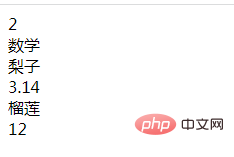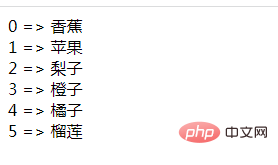What are the five ways to traverse an array in php
Five traversal methods: 1. Use "for($i=0;$i
$v)" ;3. Use "while(list($k,$v)=each(array))"; 4. Use "array_map(callback function, array)", etc.

The operating environment of this tutorial: windows7 system, PHP7.1 version, DELL G3 computer
php Five methods of traversing arrays in
Method 1: Use for loop statement
The for loop will pre-define the variable that controls the number of loops in In the for statement, the for loop statement can perform loop operations according to the known number of loops, which is suitable for situations where the number of times the script needs to be run is clearly known.
The syntax format of the for loop is as follows:
for (初始化语句; 循环条件; 变量更新--自增或自减) {
语句块;
}Let’s take a look at the code example below:
<?php
header("Content-type:text/html;charset=utf-8");
$array= array(2,"数学","梨子",3.14,"榴莲",12);
for ($i=0; $i < count($array); $i++) {
echo $array[$i] . "<br/>";
}
?>Output result:

Method 2: Use foreach loop statement
foreach is a statement specially designed for traversing arrays. It is a commonly used method when traversing arrays. It provides This is a great convenience; after PHP5, you can also traverse objects (foreach can only be applied to arrays and objects).
The foreach statement traverses the array regardless of the array subscript, and can be used for discontinuous index arrays and associative arrays with strings as subscripts.
Let’s take a closer look at the code example:
<?php
header("Content-type:text/html;charset=utf-8");
$array= array("香蕉","苹果","梨子","橙子","橘子","榴莲");
foreach ($array as $val){
echo "值是:" . $val ;
echo "<br/>";
}
echo "<br/>";
foreach ($array as $key => $value) {
echo "键名为:".$key.",键值为:".$value . "<br/>";
}
?>Output result:

Traverse the given $array array, in each loop, the value of the current array will be assigned to $value, and the key name will be assigned to $key.
Method 3: Use while loop each() list()
each() function returns the current key value in the array and moves the array pointer forward move. After each() is executed, the array pointer will stay at the next element in the array or at the last element when the end of the array is reached.
The list() function is used to assign values to a set of variables in one operation.
while loop each() function list() function can traverse the array, let’s take a look at the code example below:
<?php
header("Content-type:text/html;charset=utf-8");
$array= array("香蕉","苹果","梨子","橙子","橘子","榴莲");
while( list($key, $val) = each($array) ) {
echo "$key => $val<br>";
}
?>Output result:

Method 4: Use the array_map() function
Use an anonymous function to process each element in the array. Return a new array after the traversal is completed
<?php
$arr = [&#39;a&#39;, &#39;b&#39;, &#39;c&#39;];
var_dump($arr);
$arr = array_map(function ($item) {
return $item . &#39;_i&#39;;
}, $arr);
var_dump($arr);
?>You can process multiple arrays at the same time
<?php
header(&#39;content-type:text/html;charset=utf-8&#39;);
$arr_1 = [&#39;a&#39;, &#39;b&#39;, &#39;c&#39;];
$arr_2 = [&#39;你&#39;, &#39;好&#39;, &#39;吗&#39;, &#39;原&#39;, &#39;罪&#39;];
// $arr_n = [...];
$arr = array_map(function ($item_1, $item_2) {
return $item_1 . &#39;_&#39; . $item_2 . &#39;_i&#39;;
}, $arr_1, $arr_2);
var_dump($arr); // [&#39;a_你_i&#39;, &#39;b_好_i&#39;, &#39;c_吗_i&#39;, &#39;_原_i&#39;, &#39;_罪_i&#39;]
?>Method 5: Use the array_walk() function
to traverse your array in the form of pass-by-reference, with no return value and can only process one array.
<?php
$arr = [&#39;a&#39;, &#39;b&#39;, &#39;c&#39;];
array_walk($arr, function (&$item) {
$item = $item . &#39;_i&#39;;
});
var_dump($arr);
?>Have you noticed &$item? Yes, there is an extra &, which represents your formal parameters Data is received by reference. All you have to do is find a way to change this parameter.
Recommended learning: "PHP Video Tutorial"
The above is the detailed content of What are the five ways to traverse an array in php. For more information, please follow other related articles on the PHP Chinese website!

Hot AI Tools

Undresser.AI Undress
AI-powered app for creating realistic nude photos

AI Clothes Remover
Online AI tool for removing clothes from photos.

Undress AI Tool
Undress images for free

Clothoff.io
AI clothes remover

Video Face Swap
Swap faces in any video effortlessly with our completely free AI face swap tool!

Hot Article

Hot Tools

Notepad++7.3.1
Easy-to-use and free code editor

SublimeText3 Chinese version
Chinese version, very easy to use

Zend Studio 13.0.1
Powerful PHP integrated development environment

Dreamweaver CS6
Visual web development tools

SublimeText3 Mac version
God-level code editing software (SublimeText3)

Hot Topics
 1387
1387
 52
52
 PHP 8.4 Installation and Upgrade guide for Ubuntu and Debian
Dec 24, 2024 pm 04:42 PM
PHP 8.4 Installation and Upgrade guide for Ubuntu and Debian
Dec 24, 2024 pm 04:42 PM
PHP 8.4 brings several new features, security improvements, and performance improvements with healthy amounts of feature deprecations and removals. This guide explains how to install PHP 8.4 or upgrade to PHP 8.4 on Ubuntu, Debian, or their derivati
 7 PHP Functions I Regret I Didn't Know Before
Nov 13, 2024 am 09:42 AM
7 PHP Functions I Regret I Didn't Know Before
Nov 13, 2024 am 09:42 AM
If you are an experienced PHP developer, you might have the feeling that you’ve been there and done that already.You have developed a significant number of applications, debugged millions of lines of code, and tweaked a bunch of scripts to achieve op
 How To Set Up Visual Studio Code (VS Code) for PHP Development
Dec 20, 2024 am 11:31 AM
How To Set Up Visual Studio Code (VS Code) for PHP Development
Dec 20, 2024 am 11:31 AM
Visual Studio Code, also known as VS Code, is a free source code editor — or integrated development environment (IDE) — available for all major operating systems. With a large collection of extensions for many programming languages, VS Code can be c
 Explain JSON Web Tokens (JWT) and their use case in PHP APIs.
Apr 05, 2025 am 12:04 AM
Explain JSON Web Tokens (JWT) and their use case in PHP APIs.
Apr 05, 2025 am 12:04 AM
JWT is an open standard based on JSON, used to securely transmit information between parties, mainly for identity authentication and information exchange. 1. JWT consists of three parts: Header, Payload and Signature. 2. The working principle of JWT includes three steps: generating JWT, verifying JWT and parsing Payload. 3. When using JWT for authentication in PHP, JWT can be generated and verified, and user role and permission information can be included in advanced usage. 4. Common errors include signature verification failure, token expiration, and payload oversized. Debugging skills include using debugging tools and logging. 5. Performance optimization and best practices include using appropriate signature algorithms, setting validity periods reasonably,
 How do you parse and process HTML/XML in PHP?
Feb 07, 2025 am 11:57 AM
How do you parse and process HTML/XML in PHP?
Feb 07, 2025 am 11:57 AM
This tutorial demonstrates how to efficiently process XML documents using PHP. XML (eXtensible Markup Language) is a versatile text-based markup language designed for both human readability and machine parsing. It's commonly used for data storage an
 PHP Program to Count Vowels in a String
Feb 07, 2025 pm 12:12 PM
PHP Program to Count Vowels in a String
Feb 07, 2025 pm 12:12 PM
A string is a sequence of characters, including letters, numbers, and symbols. This tutorial will learn how to calculate the number of vowels in a given string in PHP using different methods. The vowels in English are a, e, i, o, u, and they can be uppercase or lowercase. What is a vowel? Vowels are alphabetic characters that represent a specific pronunciation. There are five vowels in English, including uppercase and lowercase: a, e, i, o, u Example 1 Input: String = "Tutorialspoint" Output: 6 explain The vowels in the string "Tutorialspoint" are u, o, i, a, o, i. There are 6 yuan in total
 Explain late static binding in PHP (static::).
Apr 03, 2025 am 12:04 AM
Explain late static binding in PHP (static::).
Apr 03, 2025 am 12:04 AM
Static binding (static::) implements late static binding (LSB) in PHP, allowing calling classes to be referenced in static contexts rather than defining classes. 1) The parsing process is performed at runtime, 2) Look up the call class in the inheritance relationship, 3) It may bring performance overhead.
 What are PHP magic methods (__construct, __destruct, __call, __get, __set, etc.) and provide use cases?
Apr 03, 2025 am 12:03 AM
What are PHP magic methods (__construct, __destruct, __call, __get, __set, etc.) and provide use cases?
Apr 03, 2025 am 12:03 AM
What are the magic methods of PHP? PHP's magic methods include: 1.\_\_construct, used to initialize objects; 2.\_\_destruct, used to clean up resources; 3.\_\_call, handle non-existent method calls; 4.\_\_get, implement dynamic attribute access; 5.\_\_set, implement dynamic attribute settings. These methods are automatically called in certain situations, improving code flexibility and efficiency.







